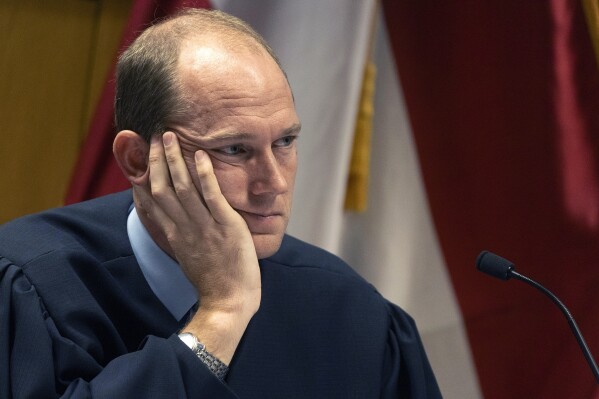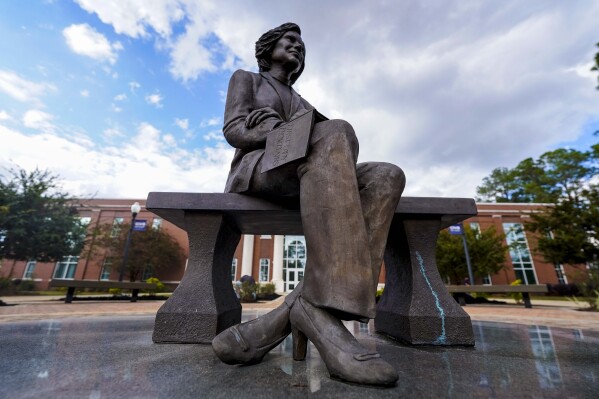Rosalynn Carter made a wrongfully convicted felon a White House nanny and helped win her pardon
PLAINS, Ga. (AP) — Rosalynn Carter was never a lawyer. But the former first lady used her powerful posts to address injustices imposed as part of the racist Jim Crow system that prevailed in Georgia courts as her husband climbed the political ladder.
The most personal of those cases for Rosalynn and Jimmy Carter involved Mary Prince Fitzpatrick, who met the Carters in Georgia’s Governor’s Mansion and went to Washington as White House nanny to their daughter Amy, with a felony murder conviction still on her record and the president of the United States as her parole officer.
The Carters were certain that Mary Fitzpatrick, who reverted to her maiden name, Prince, was wrongfully convicted, and they stuck by her until she ultimately was exonerated.
“I learned first-hand about the inadequacies and inequality in our judicial system from the prisoners who worked in the mansion,” Rosalynn wrote in her 1984 memoir. She described Mary as “a young trusty” who became a caregiver to three-year-old Amy as part of a system that allowed certain state prisoners to take jobs in state buildings.
 A judge will consider revoking a Trump co-defendant’s bond in the Georgia election subversion case
A judge will consider revoking a Trump co-defendant’s bond in the Georgia election subversion case
 Rosalynn Carter’s tiny hometown mourns a global figure — and their matriarch
Rosalynn Carter’s tiny hometown mourns a global figure — and their matriarch
 Georgia deputy who shot absolved man had been fired for excessive force. Critics blame the sheriff
Georgia deputy who shot absolved man had been fired for excessive force. Critics blame the sheriff
The relationship drew considerable attention during their White House years, from 1977 to 1981. Some of it was flattering, including a People magazine profile of Prince. Much of the coverage skewed negative, including mocking skits by NBC’S “Saturday Night Live.” After Rosalynn Carter’s death Sunday at the age of 96, her actions are in the spotlight again as an example of how she leveraged her power to help individual people.
Jimmy Carter said Mary Prince “became an integral part of our family,” and when they returned to their hometown of Plains, Georgia, Prince settled there as well, helping care for many Carter grandchildren in the ensuing decades.
Prince had been accused of murder in Lumpkin County, Georgia, in April 1970, the same year Carter was elected governor. She and a cousin went to a bar one night. Her cousin had a gun and got into an argument with a third woman. They struggled over the weapon. Mary told People magazine in 1977 the same thing she told authorities: that she tried to take the gun from them and it went off. A man, the third woman’s boyfriend, was struck and killed.
“We didn’t know it had hit anyone,” Prince told People.
The third woman told authorities Prince seized the weapon and fired it deliberately. Mary and her cousin were arrested the next day. Her cousin was released on bail. Mary had no money and sat behind bars for months until she met a court-appointed attorney shortly before her trial.
He “persuaded her to plead guilty to a murder she had hadn’t committed,” Rosalynn wrote. “She was young, Black and penniless, so she did as he told her and got a life sentence in prison.”
Prince told People she “was under the impression I was pleading guilty to involuntary manslaughter. ... The whole time in court took less than an hour.”
According to People, the attorney insisted he read the indictment to his client.
When Jimmy Carter left the governor’s office in January 1975, Prince’s mansion job ended and she returned to prison. The Carters remained convinced of her innocence.
“When I left,” Prince told People. “Amy really screamed. Later Mrs. Carter would come and see me at the Fulton County Jail and the Atlanta Work Release Center, where I went as a cook in 1975.”
She said she was “excited about Gov. Carter running for president. I’ve always had faith in him. I used to ask him questions about history and farming. He would tell me what different words meant in books I took from their library.”
When Carter won the presidency, Rosalynn Carter asked the parole board for Prince’s release. Jimmy Carter followed up with a request to be designated as her parole officer. The board agreed.
She then worked as a full-fledged White House employee, and was able to care for her own children in Washington as well. Back in Georgia, a retrial was ordered, and prosecutors decided Prince was not guilty; she ultimately received a full pardon for the original conviction.
Both Carters said later that if the bullet had struck a white man, Prince would have been executed.
Rosalynn Carter also wrote about another Governor’s Mansion trusty. “Pearl,” Rosalynn wrote, was a “mother of six” convicted of killing her husband. Carter said the man came home only on Pearl’s paydays, usually drunk, to take the money his wife earned as a dental technician. A court-appointed attorney and a judge together offered Pearl a choice: a $750 fine or life imprisonment. She had only $500 and went to prison.
“By the time we met her, she had already served several years of her sentence,” Rosalynn recalled, explaining that she did not know the back story until Pearl asked to borrow money so “she could get out of jail.” The trusty produced a document detailing the choice her sentencing judge had given her. Rosalynn Carter routed the letter to the governor’s legal advisers.
“Whether or not her crime justified more punishment is arguable,” Rosalynn wrote. “But within days she was free, on the ground of an illegal sentence.”
Rosalynn Carter also went after lawyers who took advantage of prisoners by charging them retainer fees with fraudulent promises of parole. Jimmy Carter had gotten wind of the widespread practice when he was a state senator. Rosalynn went to women’s prisons gathering details about the schemes. The Carters reported the attorneys to the Georgia State Bar Association.
Not everyone has framed the Carters’ initial relationship with Prince as positive. Black activist and author Assata Shakur cited Prince’s mansion job as an extension of a racist legal system, rather than a correction of it.
“When Jimmy Carter was governor of Georgia, he brought a Black woman from prison to clean the state house and babysit Amy,” Shakur wrote, noting the “trusty” system did not pay fair market wages. “Prisons are a profitable business. They are a way of legally perpetuating slavery.”
Jimmy Carter dedicated his book “Sharing Good Times,” published in 2004, “to Mary Prince, whom we love and cherish.”
Disclaimer: The copyright of this article belongs to the original author. Reposting this article is solely for the purpose of information dissemination and does not constitute any investment advice. If there is any infringement, please contact us immediately. We will make corrections or deletions as necessary. Thank you.


